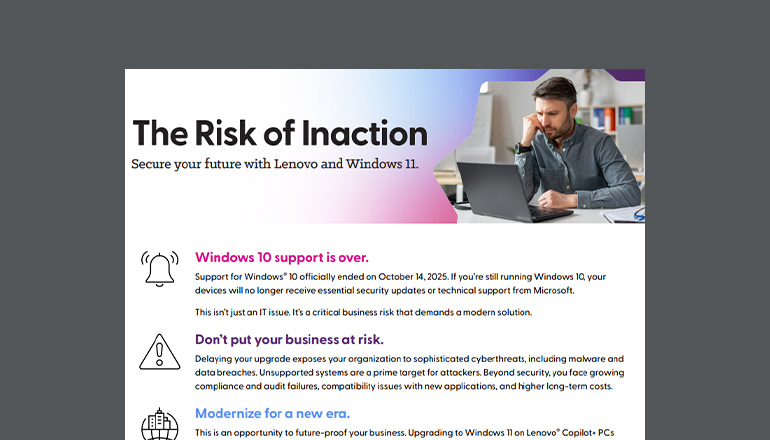Article Virtual Desktop Infrastructure Modernization
Desktop virtualization makes it easier for employees to work anytime, anywhere, from any supported device — something that’s become a necessity in 2020. But how do businesses support Virtual Desktop Infrastructure (VDI) without adding overwhelming complexity and cost to their IT initiatives?
By Emily Allender / 31 Mar 2020 / Topics: Virtualization Modern workplace Hybrid workforce Cloud

Desktop virtualization allows end users to access a desktop remotely by simulation. This creates separation between the desktop environment and its applications, and the physical device used to access it.
When done correctly, the benefits of desktop virtualization are substantial. It consolidates most of the heavy computing work in a company’s data center, allowing it to issue lower-cost devices and save on hardware costs. It helps support remote workers by providing the IT department centralized control and simplified deployment for new employees. It also makes it easier to protect the organization from a breach by keeping all data inside the data center or cloud instead of on individual machines.
Our current global environment will likely drive more intense, accelerated modernization initiatives to meet the needs of a dispersed workforce. In fact, in 2020, we’ve seen that our remote workforce can grow exponentially at the drop of a hat. Virtual desktop infrastructure can support these kinds of changes while maintaining high levels of productivity. But having the right tools and platforms in place is key.
Selecting the proper architecture
More than one-third of organizations planned to do a VDI project in 2019, representing a higher proportion than ever before, according to TechTarget. Market shifts made numerous experts forecast an increased focus on cloud and digital workspaces in regard to desktop virtualization efforts.
Organizations need to ensure they’re set up for success with desktop virtualization. Traditional approaches (ie. those with on-premises infrastructure) have been found to be too complex and difficult to manage, requiring multiple systems and operating environments, when the goal should really be a simple and unified experience.
The key to unification and simplicity might be a public cloud environment.
Research from IDC shows that organizations that use public cloud VDI solutions can realize significant value through cost and staff efficiencies, as well as user enablement. In fact, according to IDC, organizations that leverage public cloud VDI solutions save an average of 55% per-user per-year on costs, over those running entirely on premises ($549 compared to $265).
This solution has also shown to deliver gains in productivity, in the range of 35 hours of additional productivity time per-user per-year.
Leveraging partnerships in the cloud
The solution IDC highlights in its report is the integration of Citrix Virtual Apps and Desktops with Windows Virtual Desktop. This partnership is a perfect example of how companies can and do work to integrate systems in order to allow for easier management for IT teams and better experiences for end users.
Though Windows Virtual Desktop offers its own management service, organizations can now augment it with new or existing Citrix offerings. This comes as a result of concerted collaboration between Microsoft and Citrix, who announced day one support at Citrix Synergy 2019.
Both existing and new Citrix customers can consider Citrix and Windows Virtual Desktop for modern desktop virtualization. Using the Citrix Virtual Apps and Desktops service, businesses can manage workloads in hybrid fashion using familiar Citrix tools while leveraging new capabilities.
Making a move to the public cloud
Not sure if your business is ready to jump into cloud-based infrastructure? One of the biggest advantages of Citrix with Windows Virtual Desktop is the ability to slowly migrate workloads.
Because of this integration, existing Citrix customers can continue to use their on-premises solutions while also taking advantage of Azure capabilities. This allows organizations to maximize their current on-premises investments and skill sets while establishing or expanding their Azure usage.
In fact, an ESG report highlights ”full hybrid management of on-premises and Azure-hosted deployments” as one of the biggest benefits of Citrix Workspace for Windows Virtual Desktop.
The virtual desktop of the future
Modernization can mean different things to different organizations depending on where they are in their IT transformation journey. In order to make the most of what they already have and leverage more cutting-edge technologies, companies need to weigh their options carefully.
Citrix and Microsoft present a compelling way to create or reimagine the desktop virtualization experience. With close integrations, IT teams can more easily deploy and manage assets on a daily basis. And companies can get their feet wet with the public cloud by migrating some workloads to Azure while keeping their tried-and-true on-premises infrastructure with Citrix.
This partnership is an exciting leap forward in company cooperation and solution integration. Hopefully, it’s a trend that we see more of in the IT industry.








